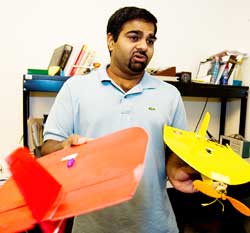Sometimes an idea just takes off

Narendra Gollu, PhD student in the hybrid control systems lab, explains applications for micro-aerial vehicles.
Rob Maguire
In the summer of 2005, Ali Dolatabadi and Luis Rodrigues (Mechanical and Industrial Engineering) found themselves defining a new capstone project for undergraduate students in Mechanical Engineering.
“It’s a required final-year project where they have to bring together the knowledge they’ve accrued and work in teams to design and manufacture something,” Dolatabadi explained.
While the project is very involved, it is also constrained in terms of time and budget. “The department contributes about $500 per group, so we’re not looking at having them design a complete engine.”
The two assistant professors finally decided students should design a micro aerial vehicle or MAV.
MAVs became a hot area of research in the 1990s when the Defense Advanced Research Projects Agency (DARPA) —which funded initial development of Internet technologies — began exploring the potential of small, low-cost aircraft which could be used for remote surveillance. How small? By definition, a micro aerial vehicle is about the size of a small bird and has a wing span of 15 cm or less. Leading edge research is now looking at vehicles the size of insects.
With a span of 30 cm, the first vehicle produced by Dolatabadi and Rodrigues’ students is technically a miniature aerial vehicle, not a micro, “although both are known as MAVs,” according to Dolatabadi. Its design won two prizes in 2006: first place in the Canadian Society for Mechanical Engineering (CSME) design competition and second place at the Student Aerospace Forum (SAF).
“We are very proud that our students have won CSME,” Rodrigues said. “It was very exciting.” So exciting that grad students in both Dolatabadi and Rodrigues’ labs have become involved. “As a teaching tool, it’s been a great project,” Rodrigues said.
Aerospace students, like Rwaa Salman in Dolatabadi’s lab, design and test the aerodynamics, while controls students in Rodrigues’ lab, like Narendra Gollu and Sharuchi Sharma, design, build and test the communication system to transfer data from the sensors to a microcontroller that can make the MAV fly.
The project has even attracted students from abroad. Benjamin Sanderse, an exchange student from the Delft Institute of Technology in the Netherlands, came to Concordia specifically for the MAV project. He returned home just last week hoping to be back at Concordia soon.
While the current machine flies, students are still not completely happy with its performance or aerodynamics. Gollu explained that the ultimate goal is for the MAV to take off and land vertically and to be able to find a target and hover over it autonomously.
The potential applications for this kind of vehicle are quite broad. “The idea is to eventually be able to mass produce, cheap, reliable MAVs for use in places where people can’t go, or don’t want to go,” Dolatabadi said.
The military applications are numerous, but as Gollu pointed out, MAVs are remarkably versatile because they can be fitted with just about any type of sensor package. “They could be sent into mines with chemical sensors to sniff out gas levels, or explore the environment of Mars.”
The extraterrestrial applications have caught the attention of the Canadian Space Agency, where Dolatabadi and Rodrigues were asked to do a presentation on the MAV project. “There’s a definite interest there.”
While work continues on the original vehicle, the students have already started developing a true MAV with a wingspan of 14 cm. Aerodynamic design is in prototype stage and sensor packages are being tested. For the new machine, wing designer Salman had to involve students in Suong Hoa’s composites lab in order to get the right materials for construction.
“It’s turning into a project the whole department can get in on,” Rodrigues said.